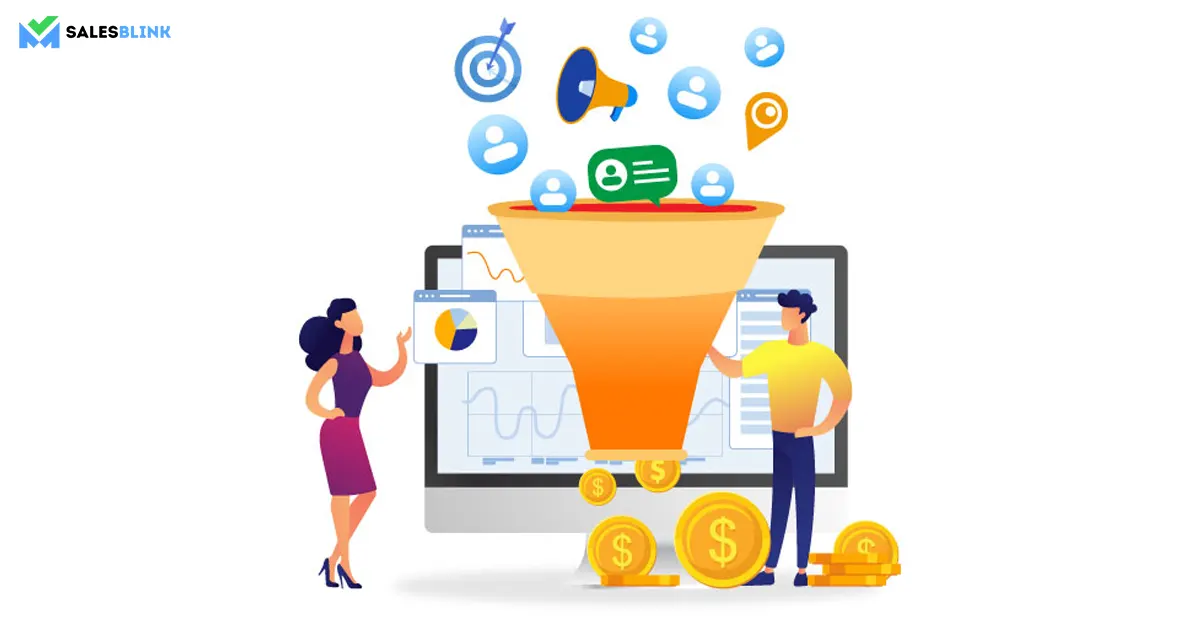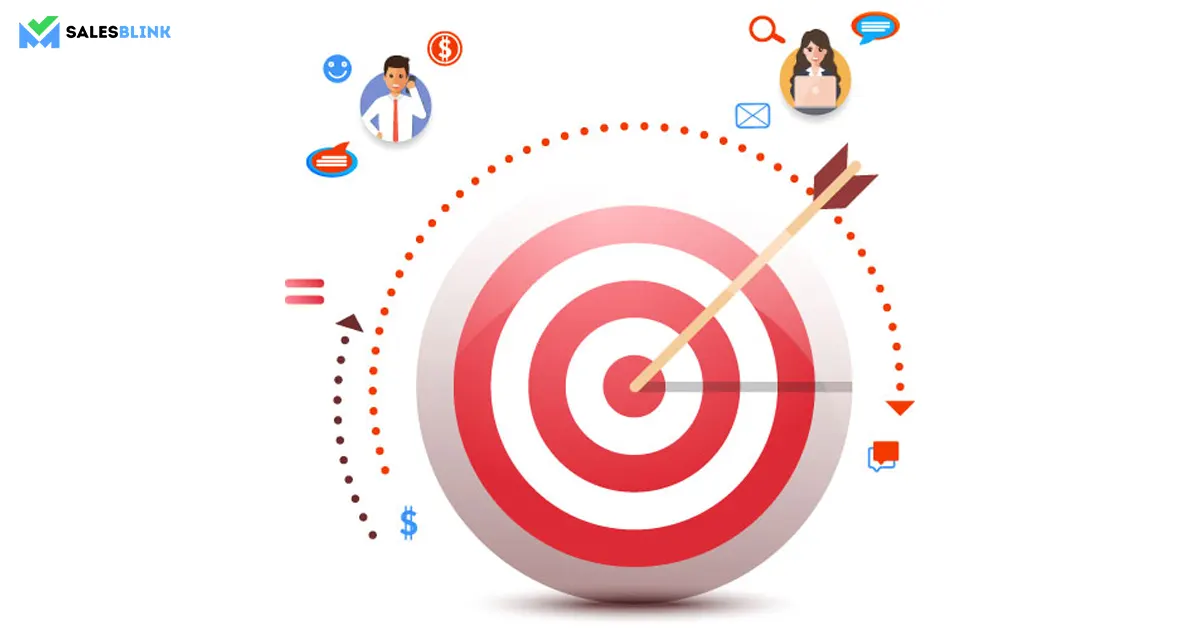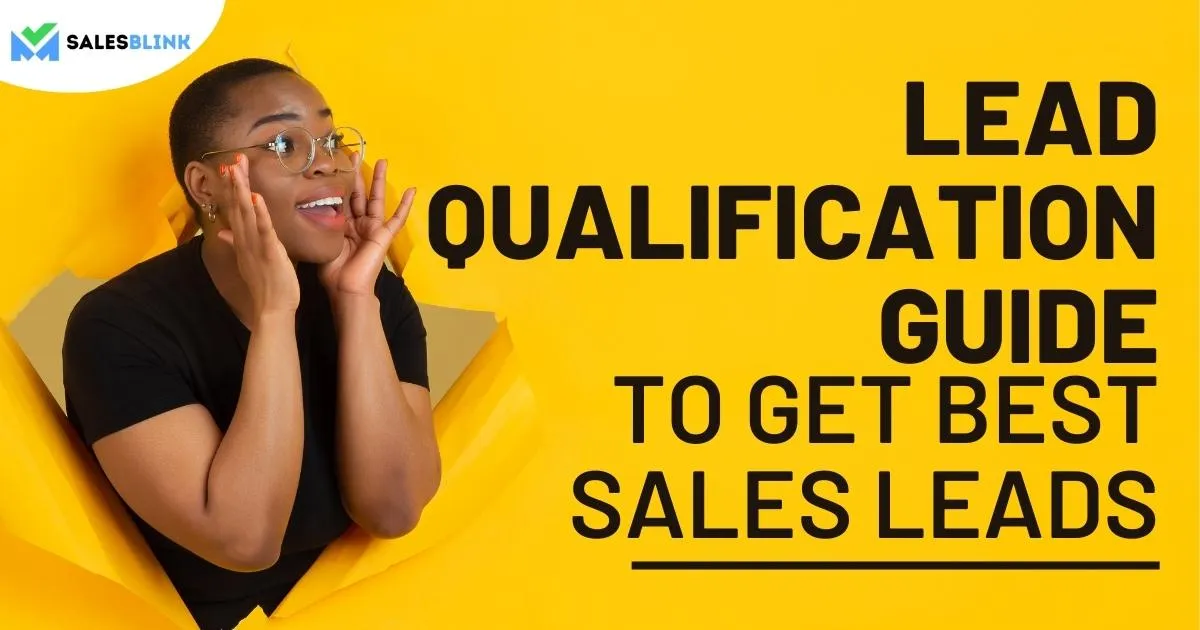The Complete Lead Qualification Guide To Get The Best Leads
Are you aware that 67% of lost sales are because reps don’t qualify prospects properly before pushing them down the sales funnel? This statistic will hopefully help you understand the significance of qualifying leads. It should always start with finding suitable leads for the product. Choosing the right lead will help you improve your conversion rates and the sales team’s productivity.
In this blog, we will give you all the information you need to know about qualifying leads in detail. We will also talk about the methods to qualify leads and why the process is important in this lead qualification guide.
Let’s begin!
Table Of Contents
What Is Lead Qualification?
It is the process of categorizing leads in such a way that the sales team knows who to prioritize and who to nurture. Using this process, you can find qualified sales leads who are ready to convert. These prospects can either be the result of outbound or inbound marketing.
You can do this by doing a small research on the lead you select. For this purpose, you will need an automation tool that will help you gather and store vital information about the future customer. There’s another method to gather useful information; via a sales call that initiates a conversation with the prospect. Some companies even use emails as their first conversation starter, and it tends to give a positive result.
Importance Of Lead Qualification
There are many ways in which this process helps your organization. It saves time for your sales team and also finds you more paying customers. In this section of the blog, we will highlight the importance of having an effective lead qualification process for your business.
But before that here is a statistic for you:
61% of B2B marketers send all leads straightaway to the sales team but, only 27% of those leads get qualified.
1. Focuses on quality leads
If you have no process to filter your leads, your sales team will be spending most of their time on leads who might never convert. But using proven methods to filter the leads helps your sales team focus on leads who will convert eventually. Or at least who is more likely to convert.
There are many ways in which you can go on about qualifying a lead. We will brief on that later. One of the most useful methods is the lead segmentation process. It will help you organize the leads based on the likeability of them making a purchase.
You can even categorize the leads as follows:
a. Hot leads – Leads who will convert immediately.
b. Warm leads – Leads that require some level of nurturing.
c. Low quality leads – Leads who you shouldn’t prioritize.
For a hot leads example, consider a walking stick for the elderly. It is only logical, you must look for people over a certain age to prioritize them. And you must give utmost priority to people who recently visited your website in search of the product.
2. Provides more accurate sales forecast
Making your forecast using assumptions is not going to get you anywhere. The lead qualification process identifies the value each lead will bring to your organization. Many businesses allot budgets based on the sales forecast model. Hence, it is very important to have an accurate method rather than assumptions to predict the outcomes.
3. Facilitates better understanding of leads
The better you understand your leads, the better deals you can offer them. Also, leads convert quickly if they find a brand that understands their needs. As you progress through the sales pipeline, it helps you lay out a more customized plan for the lead. It will help them overcome any doubts they have about purchasing the product.
Types Of Leads
As we move forward in this lead qualification guide, here are the different types of leads,

1. Unqualified leads – These leads require nurturing, and you cannot send them to the sales team.
2. Marketing qualified leads (MQL) – You can send marketing communications like email campaigns and offers to these leads.
3. Sales qualified leads (SQL) – You can connect SQLs with sales reps and start the sales process.
4. Product qualified leads (PQLs) – These are the leads that have shown an inclination towards the product by signing up for a trial.
5. Conversion qualified leads (CQLs) – CQLs are leads who have converted on your website by filling in a form or by clicking on a click-to-call button.
You can ask qualifying questions to the above leads and determine whether they are a suitable fit for your product. The qualified leads can enter the sales process and the ones that are not set aside for nurturing.
How To Qualify Leads?

Lead scoring is an amazing way to sort your leads and categorize them. But, before you start with the sales qualification process, you need to do some research on the following aspects before calculating the lead score. If you get all these details, you can effectively manage who gets to enter your sales pipeline and who doesn’t.
1. Buyer profile
For a B2C business, you need to first draw out some basic information on the customer. Initially, you would have to find your idea of an ideal customer for your brand/industry. It is often best to have lead forms in the landing pages that collect such crucial and relevant information.
You also have to be careful whom you assign the task of gathering information to. Because the sales team member must be conscious about the company’s ideal customer profile. You can assign points to the leads who fulfill the qualities. Thus, making it easy for you to sort your prospects.
2. Company profile
If you are a B2B business, you have a lot to research before contacting them. You need to find the areas where the company could use your product and how it will benefit them, before approaching them with an offer.
3. Email engagement
You must not qualify leads just because they opened your email. So a better way to do it is by tracking the open and click-through rates. Most email marketing software has features to perform such actions.
4. Social Media Engagement
Nowadays, more customers rely on reviews on social media before they make a purchase/sign up for a service. Hence, you must optimize the content you post on social media and identify people who regularly interact with your posts. According to statistics, the more engaged the lead is on social media, the more likely they are to close a deal quicker.
5. Spam detection
Yes, you need to check the lead’s authenticity before moving forward with the lead qualification process. Some leads do not have the interest to ever buy your product. But they still pose every quality of a good lead. Also, be wary of automated bot inquiries. You can filter them out by adding a Captcha before being able to submit the form.
What Are The Qualifying Questions You Should Ask Leads?
Further in this lead qualification guide are some of the qualifying questions that you can ask leads,
1. What problem do you wish to find a solution to?
2. Are you using another solution to resolve this problem presently?
3. What do you want to achieve by using this solution?
4. What is your implementation timeline?
5. Who in your organization will make the final call for this purchase?
6. How much budget have you allocated for this solution?
The above questions focus on the budget of the prospect’s organization, finding the decision-maker and the implementation timeline.
Lead Scoring
Now that you have all this information on the prospect, it is time to move forward with the lead scoring process. You can follow the steps below to effectively score the leads:

#1: Set goals: To achieve your conversion rate goals, you must find the optimal number for your highly qualified sales lead requirements. And then work towards fulfilling the set goals.
#2: Choose the ideal characteristics: Go through your past customer data. Identify the qualities of customers who nurtured into paying customers.
#3: Estimate close rates: Based on the qualities, find out how many of your current leads are likely to close a deal with your business.
#4: Compare qualities: Compare the current lead qualities with the past high-quality leads. Based on the comparison, you can assign points to the leads who closely match your ideal customer profile.
You can either do these hectic tasks manually or choose to buy a CRM tool. It basically handles all your customer and lead information. When integrated with marketing software, you can perform lead qualification without having to go through all that manual lead scoring methods. Most tools automatically collect and perform analytics on each lead.
Effective Lead Qualification Frameworks
After knowing the steps of lead scoring, you must think that there is umpteen number of ways to go about these steps. But luckily we have some efficient tried and tested methods that improve the way you select your leads. Let’s take a quick look at the lead qualification methods,
1. BANT
BANT stands for Budget, Authority, Need, and Time. It is a framework designed to help you compare the business goals with the lead’s needs. The first step is to look into the budget of the lead. See whether they are capable of paying/ willing to pay for your product. If you are engaging in a B2B business, ensure that the lead you follow has the final authority to say yes to a purchase.
Then, identify the needs of the lead. Check if they match your business goals. The final step is to know the timeline within which they will make a purchase. This process is fairly simple and straightforward. For businesses that do not have a standard framework, you can use this and move on to the advanced ones from here.
2. CHAMP
CHAMP stands for Challenges, Authority, Money, and Priority. As you can see, it is quite similar to BANT, but in a mixed-up order. This lead qualification framework urges you to identify the challenges the lead is looking to solve before getting into the details. If you provide a custom service, this framework would work fine for you. Because you have to find out whether you can meet the lead’s requirements before progressing.
3. FAINT
FAINT is an acronym for Funds, Authority, Interest, Need, and Timing. It is very similar to BANT, but it has ‘Interest’ as the added aspect. You cannot always expect the customers to be all about the needs and budget. Sometimes even if they have a need for a product, they would not invest their time unless they have an interest in buying it. This framework also encourages you to engage with the leads to create interest in the brand/product. Most companies that sell non-essential items use this strategy.
4. ANUM
ANUM is almost the same as BANT, but it replaces Timing with Urgency. IT stands for Authority, Need, Urgency, and Money. Some leads do not have to go through the entire sales cycle to convert into paying customers. This framework focuses on such leads. Hence, this one is a perfect fit for companies with a smaller sales cycle. And for those who intend to close more deals quicker.
5. NEAT
NEAT stands for Needs, Economic Impact, Authority, and Timeline. It covers one of the most important aspects of qualifying the leads. It considers the economic impact of the product you are going to sell. Therefore, the lead understands that you offer unparalleled service/product. It lets you create a more sellable narrative to improve the recognition of the brand.
6. GPCTBA/C&I
This covers quite a lot of ground. The expansion for this is Goals, Plans, Challenges, Timeline, Budget, Authority, Negative Consequences, and Positive Implications. The part where it says negative consequences covers the topics of what happens when your product fails the customer. It details how the negative feedback from the lead will impact your monetary profits. It helps you offer a viable deal to the leads.
Positive implications focus on identifying how your product will help the prospect overcome a certain problem. It also lets you research whether it will stick to its original goal or go beyond that and help the prospects in other ways as well. You cannot always just talk about product specs to perform lead qualifications. Hence, it is important for you to identify how it adds value to the prospects.
There are many other frameworks using which you can improve your lead selection process. While selecting one for your business, make sure it aligns well with your buyer profile and your business structure. It also depends on what you are selling and the success rate of the current framework.
Best Practices To Qualify Leads
Here are a few lead qualification best practices.
1. Set up a dedicated team
Within the sales team, you must employ a dedicated group of members to perform the lead qualification process. Since it is a time-intensive process, assigning the job to your sales reps will only make the process more inefficient. Outsourcing to a lead qualification service can be a huge help if you lack in-house resources.
2. Have only two states of qualifications
Your lead must either be a qualified lead or an unqualified lead. Do not make it complex by adding more types of qualifications. This is because keeping your leads strictly between the two labels reduces lead dropping through the gaps in the sales pipeline.
3. Employ automation where possible
Nowadays, you can use automation everywhere. It helps improve the overall quality of the process. By visualizing the process, you can greatly reduce the occurrence of any errors along the way. You have modern automated lead qualification software that will help you while you scale your business.
4. Monitor the performance
Like any business model, you must have systems in place to check the efficiency of your method occasionally. It will enable you to keep track of the quality leads and better understand the current mindset of the audience. It will also help you find out ways through which you can improve the whole system.
When Should You Disqualify Leads?
While our lead qualification guide talks about qualifying leads, there is nothing wrong with disqualifying leads. You shouldn’t think twice before doing it. For example, if the prospect doesn’t match the buyer persona or ideal customer profile, it is better to disqualify them in the initial stage. That will prevent you from wasting your resources on a lead who is not going to convert. You can keep them aside and focus on just the potential customers who are a perfect fit for your product or service.
Here’s another example – The prospect may be meeting all your criteria, but you discover that they don’t have a problem that your solution solves. Therefore, there is no need for your solution, which is a solid reason to disqualify the prospect.
Start Qualifying Leads & Land More Deals!
The lead qualification has become a vital procedure in this ever-flattening business world. More leads pour in every day and this is why you need to have lead qualification strategies to handle all those leads and categorize them carefully. The above lead qualification guide will be helpful. You can employ modern solutions where you can, to boost productivity and your revenue.
FAQs
It is the process of categorizing leads in such a way that the sales team knows who to prioritize and who to nurture. Using this process, you can find qualified leads who are ready to convert.
You can send marketing communications like email campaigns and offers to MQL leads. These qualified leads can enter the sales process and the ones that are not set aside for nurturing
CQLs are leads who have converted on your website by filling in a form or by clicking on a click-to-call button. Ask qualifying questions to these leads and determine whether they are a suitable fit for your product.
By qualifying leads, businesses can focus their resources and efforts on those prospects who are most likely to convert into paying customers, thereby increasing the chances of a successful sale.







